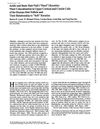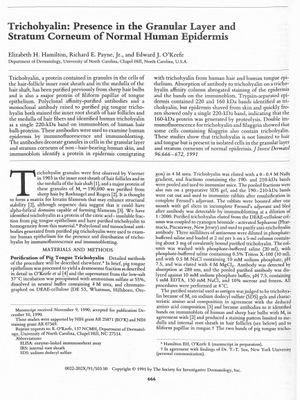TLDR Trichohyalin is also found in the outer layers of normal human skin.
The study demonstrated that trichohyalin, a protein previously known to be present in hair follicles and tongue epithelium, was also found in the granular layer and stratum corneum of normal human epidermis. Using polyclonal and monoclonal antibodies, researchers identified trichohyalin as a 220-kDa band in human hair bulb proteins and confirmed its presence in the epidermis through immunofluorescence and immunoblotting. The study also revealed that trichohyalin coexists with filaggrin in some epidermal cells, indicating its broader distribution beyond hair and tongue tissues.
39 citations
,
February 1990 in “The journal of cell biology/The Journal of cell biology” Trichohyalin, a hair follicle protein, has a part with repeating patterns of 23 amino acids.
128 citations
,
March 1989 in “Experimental Cell Research” Hoxc13 is important for hair and tongue development by controlling hair keratin genes.
187 citations
,
May 1988 in “Differentiation” Trichocytic cytokeratins are found in hair, nails, tongue, and thymus cells, showing complex regulation in tissue development.
248 citations
,
April 1988 in “Differentiation” Human and bovine hair follicles have distinct cytokeratins specific to hair-forming cells.
 356 citations
,
December 1986 in “The journal of cell biology/The Journal of cell biology”
356 citations
,
December 1986 in “The journal of cell biology/The Journal of cell biology” Hair and nail cells share similar proteins, indicating a common differentiation pathway.
116 citations
,
April 1986 in “The journal of cell biology/The Journal of cell biology” Trichohyalin is a protein in hair follicles that helps form hair filaments.
February 2022 in “Cosmetic Dermatology” Healthy skin prevents water loss and protects against threats.
September 2012 in “대한피부과학회지” Desmocollin 1 helps maintain skin structure during fetal development.
5 citations
,
August 2012 in “Experimental Dermatology” Artemis phosphorylation at Ser516 may help regulate skin and hair structures.
21 citations
,
September 2005 in “The anatomical record. Part A, Discoveries in molecular, cellular, and evolutionary biology/Anatomical record. Part A, Discoveries in molecular, cellular, and evolutionary biology” Caspase-14 is important for skin and hair development in all mammals.
1 citations
,
January 1989 Four antibodies were developed to help study hair follicle cell differentiation.
7 citations
,
January 1988

